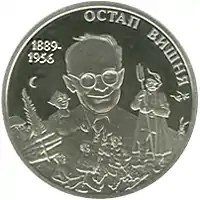Ostap Vyshnya
Ostap Vyshnia (real name Pavlo Hubenko,[1] November 13 [O.S. November 1] 1889 – 28 September 1956) was a Ukrainian writer, humourist, satirist, and medical official (feldsher). Nicknamed by many critics as the Ukrainian Mark Twain and the Ukrainian Printing King; His fame was said to have competed in early Soviet Ukraine only two: Taras Shevchenko and Vladimir Lenin.[2]
Pavlo Hubenko Павло Михайлович Губенко | |
|---|---|
 | |
| Born | November 13 [O.S. November 1] 1889 Zinkiv uyezd, Poltava Governorate |
| Died | 28 September 1956 (aged 66) Kyiv, Soviet Union |
| Pen name | Ostap Vyshnia Остап Вишня |
| Occupation | writer |
| Citizenship | Russian Empire, Soviet Union |
| Period | 1919-1956 |
| Genre | humoresque, feuilleton |
Early life
.jpg.webp)

Pavlo Hubenko was born in a large peasant family of 17 children on 13 November 1889 in the khutir (farmstead) Chechva near the small town of Hrun, in Zinkiv uyezd, at the time in the Poltava Governorate of the Russian Empire. Today his place is in Sumy Oblast while Zinkiv is a city in Poltava Oblast, both in Ukraine. He studied in elementary school in Zinkiv, later enrolling into the Kyiv military-nursing school which he finished in 1907. He worked as a nurse in the Army and then at the surgical department of the South-Western Railways hospital. He finally managed to take the tests to enroll into the Kyiv University in 1917, but later (1919) dropped out of it and was fully was overtaken by journalism and literary works. In 1919 he was captured by Bolsheviks while being in the Ukrainian Army and heavily sick of typhus. Remarkable is the fact that he also served as the chief of the medical-sanitary directorate of Ukrainian Ministry of Railways (Transport). Until 1921 he spent time in Kharkiv's prison till the complete end of the Civil War. During the times of Directorate of Ukraine he became known for his phrase: Inside the wagon - Directory, under the wagon - territory. In 1933, he was sentenced to 10 years in a forced labour camp.[1] Vyshnia was one of the few representatives of the Renaissance group who survived the execution.[3]
Career and repression

Hubenko's first published work, Denikin's Democratic Reforms, appeared on 2 November 1919 in the newspaper Narodna Volia under the pen name P. Hrunsky.
Several satirical articles were also printed in this same newspaper by the young writer. His period of regular publication began in April 1921, when he became a journalist with the government newspaper News of the All-Ukrainian Central Executive Committee (Ukrainian: Вісті ВУЦВК). The pen name Ostap Vyshnia first appeared in The Peasant Truth on 22 July 1921, in the feuilleton Odd Fellow, Really!.
In 1933 he was sent to the labour camps for ten years, and he was able to return to his literary career only in 1943. He was rehabilitated in 1955.
Death
Ostap Vyshnya died on 28 September 1956 in Kyiv. His funeral reportedly filled Khreshchatyk street.[4] He is buried at the Baikove Cemetery.
Works
Hard Times (translation into English of best humour & satire spanning his whole career), published 1981, transl. by Yuri Tkacz, Bayda Books, Australia
References
- Vyshnia, Ostap (2018-06-05). Hard Times. Glagoslav Publications. ISBN 978-1-911414-80-3.
- Finnin, Rory (2022-03-01). Blood of Others: Stalin's Crimean Atrocity and the Poetics of Solidarity. University of Toronto Press. ISBN 978-1-4875-3701-2.
He was Ukraine's "Mark Twain," the "king of the Ukrainian print-run," whose fame, it was said, rivalled only two others in early Soviet Ukraine: Taras Shevchenko and Vladimir Lenin.
- Kowal, Pawel Mink, Georges Reichardt, Iwona Reichardt, Adam (2019-11-30). Three Revolutions: Mobilization and Change in Contemporary Ukraine II. BoD – Books on Demand. p. 299. ISBN 978-3-8382-1323-1.
{{cite book}}: CS1 maint: multiple names: authors list (link) - Fowler, Mayhill C. (2017-01-01). Beau Monde on Empire's Edge: State and Stage in Soviet Ukraine. University of Toronto Press. ISBN 978-1-4875-0153-2.
External links
- Yurkova, O.V. Ostap Vyshnia (ВИШНЯ Остап). Encyclopedia of History of Ukraine.
- Koshelivets, I. Vyshnia, Ostap. Encyclopedia of Ukraine.